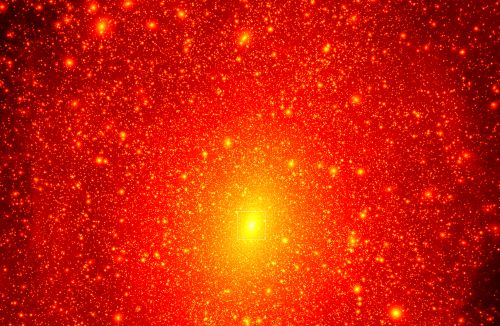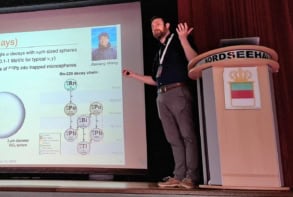
Cosmologists in the US and Switzerland have made the most detailed simulation yet of how gravitational interactions have led to the “haloes” of dark matter we see near the centres of galaxies today. The feat could help future experiments grasp the nature of the dark matter, an elusive substance thought to make up nearly a quarter of the universe.
The simulation, which took over a month to run on a supercomputer, charts the evolution of over a billion dark-matter particles since a few million years after the Big Bang. It reveals that the dark-matter haloes are less smooth than previously thought.
“This is the best resolved calculation of the Milky Way’s halo ever carried out, with a mass resolution five to sixty times better than the previous largest computations,” explains Piero Madau at the University of California, Santa Cruz. “Previously, the inner regions of the halo came out smooth but now we have enough detail to see dense clumps of dark matter.”
It’s like taking a picture of a cricket stadium and being able to see individual grass leaves, instead of just patches of green Asantha Cooray, University of California at Irvine
Small-scale structure
Physicists believe dark matter makes up the bulk of all matter in the universe, outnumbering normal matter by roughly five to one. Invisible to modern telescopes, it gives off no light or heat and interacts only through gravity. Its prevalence also means that dark matter has had a significant impact on the structural evolution of the universe.
Madau — together with colleagues at Santa Cruz, the Institute of Advanced Study, New Jersey, and the University of Zurich — performed his simulations using the widely accepted “cold” dark-matter model of the universe. According to this model, gravity acted initially on slight density fluctuations present shortly after the Big Bang to pull together the first clumps of dark matter. These merged and grew into ever larger clumps, creating “gravitational wells” that ordinary matter fell into and formed stars and planets, giving rise to galaxies in the centres of dark matter halos.
Although past simulations have had reasonable success at describing cosmological evolution, understanding the nature of dark matter would be helped by knowledge of its smaller-scale structure. To achieve this, Madau and colleagues had to use 3,000 processors in parallel for around a month to follow the gravitational interactions of 1.1 billion particles of dark matter. The simulation started 20 million years after the Big Bang and took into context 13.7 billion years of evolution, producing a halo the same size as the one in the Milky Way.
Their results revealed a Russian-doll structure, with entire generations of progenitor dark matter clumps preserved as a series of nested substructures. The simulation showed that dense clumps should lurk in the inner regions of a halo (Nature 457 735).
Looking for evidence
“For the first time, a numerical simulation is now able to study the dark matter makeup of a typical galaxy down to mass scales of a thousand solar masses instead of a few hundred thousand as before,” says Asantha Cooray, a cosmologist at the University of California, Irvine. “This is equivalent to taking a picture of a cricket stadium and finally being able to see individual grass leaves, instead of just patches of green.”
Physicists believe dark matter particles, such as so-called weakly interacting massive particles (WIMPs), can collide and annihilate each other while emitting gamma rays. These could be detected by space-based telescopes, including the recently launched GLAST. According to Madau and his colleague Juerg Diemand, the denser clumps predicted by their simulation should emit lots of gamma rays, allowing for easy detection.
Robert Caldwell at Dartmouth College, New Hampshire, thinks the team’s simulation should help understand the potential signals from GLAST and other particle dark matter searches. “It would be tremendously exciting to see astrophysical evidence,” he says, adding: “and imagine the timing, just as searches are pushing the limits of our conception of dark matter!”



